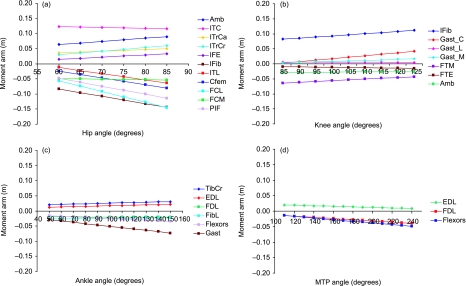Fig. 3.
(a) Muscle moment arm lengths for muscles acting across the hip joint (muscles in order top to bottom: Amb, ambiens; ITC, iliotibialis cranialis; ITrCa, iliotrochantericus caudalis; ITrCr -iliotrochantericus cranialis; IFE, iliofemoralis externus; IFib, iliofibularis; ITL, iliotibialis lateralis; CFem, caudofemoralis; FCL, flexor cruris lateralis; FCM, flexor cruris medialis; PIF, pubo-iscio-femoralis). Positive values indicate flexor moment arms and negative values indicate extensor moment arms. Data are mean values scaled to a 70 kg ostrich from bone lengths. (b) Muscle moment arm lengths for muscles acting across the knee joint (muscles in order top to bottom: IFib, iliofibularis; Gast_C, caudal head of gastrocnemius; Gast_L, lateral head of gastrocnemius; Gast_M, medial head of gastrocnemius; FTM, femorotibialis medius; FTE, femorotibialis externus; Amb, ambiens). Positive values indicate flexor moment arms and negative values indicate extensor moment arms. Data are mean values scaled to a 70-kg ostrich from bone lengths. (c) Muscle moment arm lengths for muscles acting across the ankle joint. (muscles in order top to bottom: TibCr, tibialis cranialis; EDL, extensor digitorum longus; FDL, flexor digitorum longus; FibL, fibularis longus; Flexors, superficial digital flexors; Gast, gastrocnemius). Positive values indicate flexor moment arms and negative values indicate extensor moment arms. Data are mean values scaled to a 70-kg ostrich from bone lengths. (d) Muscle moment arm lengths for muscles acting across the metatarsophalangeal (MTP) joint (muscles in order top to bottom: EDL, extensor digitorum longus; FDL, flexor digitorum longus; Flexors, superficial digital flexors). Negative values indicate flexor moment arms and positive values indicate extensor moment arms. Data are mean values scaled to a 70-kg ostrich from bone lengths.

